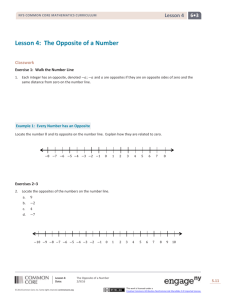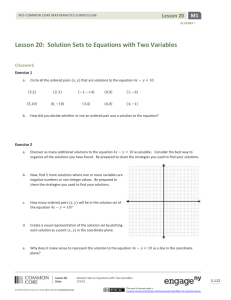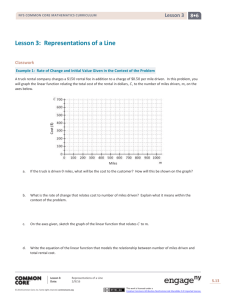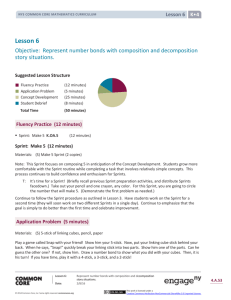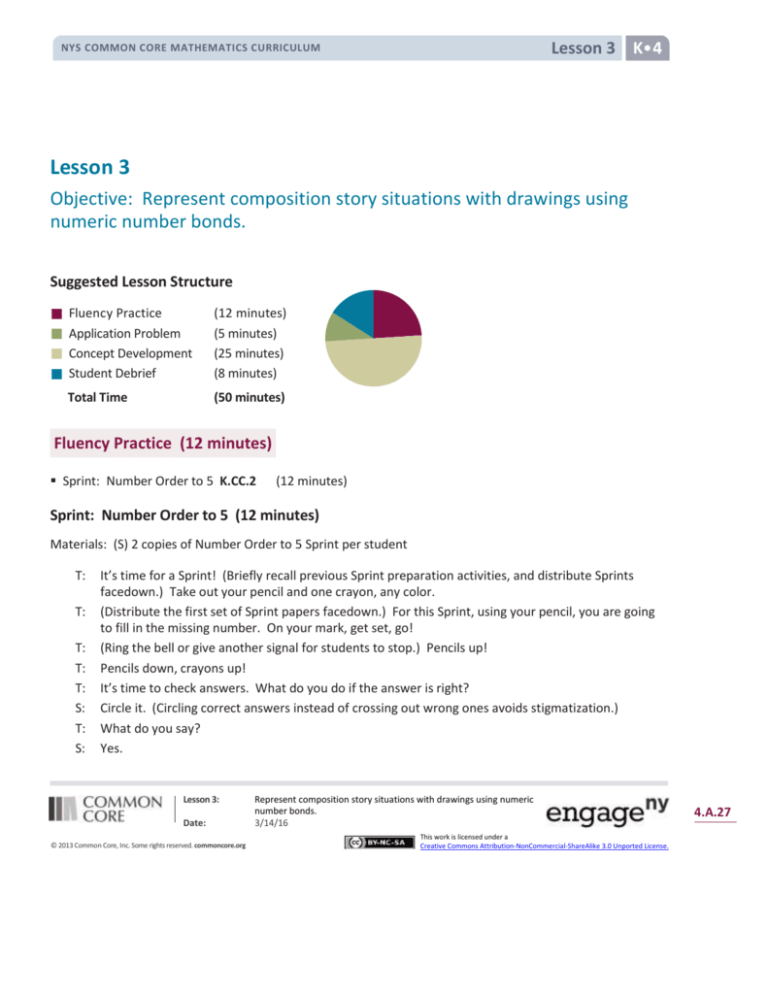
Lesson 3 K
NYS COMMON CORE MATHEMATICS CURRICULUM
Lesson 3
Objective: Represent composition story situations with drawings using
numeric number bonds.
Suggested Lesson Structure
Fluency Practice
Application Problem
Concept Development
Student Debrief
Total Time
(12 minutes)
(5 minutes)
(25 minutes)
(8 minutes)
(50 minutes)
Fluency Practice (12 minutes)
Sprint: Number Order to 5 K.CC.2
(12 minutes)
Sprint: Number Order to 5 (12 minutes)
Materials: (S) 2 copies of Number Order to 5 Sprint per student
T:
T:
T:
T:
T:
S:
T:
S:
It’s time for a Sprint! (Briefly recall previous Sprint preparation activities, and distribute Sprints
facedown.) Take out your pencil and one crayon, any color.
(Distribute the first set of Sprint papers facedown.) For this Sprint, using your pencil, you are going
to fill in the missing number. On your mark, get set, go!
(Ring the bell or give another signal for students to stop.) Pencils up!
Pencils down, crayons up!
It’s time to check answers. What do you do if the answer is right?
Circle it. (Circling correct answers instead of crossing out wrong ones avoids stigmatization.)
What do you say?
Yes.
Lesson 3:
Date:
© 2013 Common Core, Inc. Some rights reserved. commoncore.org
Represent composition story situations with drawings using numeric
number bonds.
3/14/16
This work is licensed under a
Creative Commons Attribution-NonCommercial-ShareAlike 3.0 Unported License.
4.A.27
Lesson 3 K
NYS COMMON CORE MATHEMATICS CURRICULUM
T:
S:
We’ll begin at the top. Ready? 5.
Yes!
Continue checking the remaining answers, then have students count how many correct and write the number
at the top. Keep the mood celebratory.
T:
S:
T:
S:
T:
S:
T:
Before we try again, let’s get our mind and body ready to work hard with an exercise. Stand up and
push in your chairs. Let’s touch our toes while counting to 10. Ready?
1, 2, 3, …10 (touch toes at every count).
Hands on your hips, twist slowly, counting down from 10. Ready? (While students exercise,
distribute the second set of Sprints, which is the same as the first.)
10, 9, 8, …1 (while twisting).
Have a seat. Pencils up. Do you remember the number you got the first time?
Yes.
See if you can beat your score! Race against yourself! On your mark, get set, go!
Students work on the Sprint for a second time. Give the signal to stop, reiterating that is ok not to finish.
Continue to emphasize that the goal is simply to do better than the first time. Proceed through the checking
answers procedure with more enthusiasm than ever. Then, facilitate a comparison of Sprint A to Sprint B.
Because students are still developing understanding of the concept of more, it may be necessary to circulate
and facilitate the comparison, either visually, or numerically.
T:
T:
Stand up if you beat your score.
Let’s celebrate (e.g., congratulate each other, give three pats on the back, shake hands, have a
parade, etc.).
Variation: Allow students to finish, but provide an early finisher activity to do on the back.
Lesson 3:
Date:
© 2013 Common Core, Inc. Some rights reserved. commoncore.org
Represent composition story situations with drawings using numeric
number bonds.
3/14/16
This work is licensed under a
Creative Commons Attribution-NonCommercial-ShareAlike 3.0 Unported License.
4.A.28
Lesson 3 K
NYS COMMON CORE MATHEMATICS CURRICULUM
Application Problem (5 minutes)
Materials: (S) Set of 5 linking cubes per student, number bond
template in personal white boards
Chris had 3 baseball cards. Use your cubes to show his cards.
Katharine had 2 baseball cards. Show her cards with your
cubes. Now, with your cubes, show how many cards they have
together.
Make a picture on your personal board to show the story. Can
you make a number bond picture about your story? Talk about
your work with your partner.
Note: This problem sets the stage for compositions of numbers
to 5 in today’s lesson and is the first time students are making a
number bond drawing without a template.
Lesson 3:
Date:
© 2013 Common Core, Inc. Some rights reserved. commoncore.org
A NOTE ON
MULTIPLE MEANS OF
REPRESENTATION:
Scaffold the Application Problem for
your students who are below grade
level by modeling your directions step
by step, “Let’s show 3 baseball cards.
Count with me, 1, 2, 3. Now let’s show
Katharine’s 2 baseball cards. 1, 2,”
until students are able to work on their
own.
Represent composition story situations with drawings using numeric
number bonds.
3/14/16
This work is licensed under a
Creative Commons Attribution-NonCommercial-ShareAlike 3.0 Unported License.
4.A.29
Lesson 3 K
NYS COMMON CORE MATHEMATICS CURRICULUM
Concept Development (25 minutes)
Materials:
T:
S:
T:
T:
S:
T:
S:
T:
S:
MP.4
T:
S:
(S) Number bond template in personal white board
NOTES ON
MULTIPLE MEANS OF
REPRESENTATION:
Close your eyes and imagine this story. Two squirrels
As you introduce the terms part and
whole make sure that your English
were playing in the park. Two more squirrels came to
language learners are clear that you
join them. Now, open your eyes. In one of your
are saying whole and not hole. Teach
hoops, one of the parts, draw squares to show the
them the difference between the two
squirrels that were first playing in the park.
words by showing them a picture of a
(Demonstrate.) In another hoop, the other part, draw
hole and a picture of a whole apple cut
squares to show the squirrels that joined them.
into parts. Post the pictures and the
(Demonstrate.) Where would we draw the squares to
written words on your word wall.
show all of the squirrels together? (Allow time for
discussion.)
In the hoop with two paths! We would draw 4 squares there.
Yes, we would draw cubes for all of the squirrels together in the
whole (demonstrate). Finish your number bond on your personal
board and hold it up.
What would happen if we turned our number bond around so that
the whole is on the left? Try it. Does it change our story?
No. It just looks different. The squirrels are the same. To
me, it makes the story start with the 4 squirrels. I saw 4 squirrels.
2 were in the park and 2 more came to play.
Sometimes I get so tired of drawing squares! Would it be fair to
use a secret shortcut? How many squares are in this part?
2.
Can we erase the squares in that part and write a 2 instead?
Would that be fair?
Yes! You could put a number for the squares! You could use
numbers instead of the pictures.
Let me replace my squares with numbers. (Demonstrate.) Have I
changed anything about the story?
No. It just looks different. You just used numbers instead.
Lesson 3:
Date:
© 2013 Common Core, Inc. Some rights reserved. commoncore.org
Represent composition story situations with drawings using numeric
number bonds.
3/14/16
This work is licensed under a
Creative Commons Attribution-NonCommercial-ShareAlike 3.0 Unported License.
4.A.30
Lesson 3 K
NYS COMMON CORE MATHEMATICS CURRICULUM
T:
T:
T:
T:
T:
S:
T:
S:
T:
S:
T:
Count the squares in each of your hoops, erase them, and write the numbers instead. Turn and talk
to your partner about the secret shortcut. (Allow time for discussion.)
Erase your personal boards. Listen to my next story and draw a picture on your personal board to
show what happens.
John read 3 picture books one night. Draw his books. (Pause to allow time for drawing.) The next
night, he read 2 more picture books. Draw his new books. (Pause to allow time for drawing.) How
many books did John read?
Hold up your personal board to show me John’s books. (Circulate to ensure accuracy.)
Great! Let’s use our secret shortcut to make a number bond for this story. How many books did
John read the first night?
3.
Write the number 3 in this part of the number bond. (Demonstrate). How many books did he read
the second night?
2.
Write the number 2 in this part of the number bond. Now, turn and talk to your partner to find out
how many books John read in all. (Allow time for discussion.) How many?
5!
Write the number 5 in the whole part of the number bond. We did it! Hold up your personal board!
(Circulate to ensure accuracy.)
Use other combinations to create additional number bonds. For example, “What if John had read only 1 book
the first night and 4 the second? How would that change our number bond? Could you write the number
bonds using only numbers?” Let students practice writing the bonds without demonstrating on the board.
Problem Set (10 minutes)
Students should do their personal best to complete the Problem Set within the allotted 10 minutes.
Lesson 3:
Date:
© 2013 Common Core, Inc. Some rights reserved. commoncore.org
Represent composition story situations with drawings using numeric
number bonds.
3/14/16
This work is licensed under a
Creative Commons Attribution-NonCommercial-ShareAlike 3.0 Unported License.
4.A.31
Lesson 3 K
NYS COMMON CORE MATHEMATICS CURRICULUM
Student Debrief (8 minutes)
Lesson Objective: Represent decomposition story
situations with drawings using numeric number bonds.
The Student Debrief is intended to invite reflection and
active processing of the total lesson experience.
Invite students to review their solutions for the Problem
Set. They should check work by comparing answers with a
partner before going over answers as a class. Look for
misconceptions or misunderstandings that can be
addressed in the Debrief. Guide students in a
conversation to debrief the Problem Set and process the
lesson.
You may choose to use any combination of the questions
below to lead the discussion.
What is a part? What is the whole? How do they
work together?
Does it matter if we use pictures or numbers to
show a story? Does it matter if we use pictures
or numbers in our number bond? Why or why
not?
Lesson 3:
Date:
© 2013 Common Core, Inc. Some rights reserved. commoncore.org
Represent composition story situations with drawings using numeric
number bonds.
3/14/16
This work is licensed under a
Creative Commons Attribution-NonCommercial-ShareAlike 3.0 Unported License.
4.A.32
Lesson 3 K
NYS COMMON CORE MATHEMATICS CURRICULUM
Look at the smiley faces on your Problem Set.
Did your neighbor put the yellow (gray) faces and
the white faces in the same parts as you did?
Does it matter where we draw the smiley faces
that are in the parts?
What is the fastest way to tell about the triangles
and squares in a number bond? Drawing the
shapes or writing the numbers?
Does it make a difference where I write the
numbers in the number bond?
Lesson 3:
Date:
© 2013 Common Core, Inc. Some rights reserved. commoncore.org
Represent composition story situations with drawings using numeric
number bonds.
3/14/16
This work is licensed under a
Creative Commons Attribution-NonCommercial-ShareAlike 3.0 Unported License.
4.A.33
NYS COMMON CORE MATHEMATICS CURRICULUM
Lesson 3 Sprint K•4
Fill in the missing number.
0, 1, 2, 3, 4, _____ _____, 4, 3, 2, 1, 0
0, 1, 2, 3, _____, 5 5, _____, 3, 2, 1, 0
0, 1, 2, _____, 4, 5 5, 4, _____, 2, 1, 0
0, 1, _____, 3, 4, 5 5, 4, 3, _____, 1, 0
0, _____, 2, 3, 4, 5 5, 4, 3, 2, _____, 0
_____, 1, 2, 3, 4, 5 5, 4, 3, 2, 1, _____
0, _____, 2, 3, 4, 5 0, 1, 2, 3, _____, 5
0, 1, _____, 3, 4, 5 5, 4, _____, 2, 1, 0
Lesson 3:
Date:
© 2013 Common Core, Inc. Some rights reserved. commoncore.org
Represent composition story situations with drawings using numeric
number bonds.
3/14/16
This work is licensed under a
Creative Commons Attribution-NonCommercial-ShareAlike 3.0 Unported License.
4.A.34
NYS COMMON CORE MATHEMATICS CURRICULUM
Lesson 3 Sprint K•4
0, 1, 2, _____, 4, 5 0, 1, _____, 3, 4, 5
0, 1, 2, 3, _____, 5 _____, 1, 2, 3, 4, 5
Lesson 3:
Date:
© 2013 Common Core, Inc. Some rights reserved. commoncore.org
Represent composition story situations with drawings using numeric
number bonds.
3/14/16
This work is licensed under a
Creative Commons Attribution-NonCommercial-ShareAlike 3.0 Unported License.
4.A.35
NYS COMMON CORE MATHEMATICS CURRICULUM
Name
Lesson 3 Problem Set K•4
Date
Draw and write the numbers to complete the number bonds.
5
Lesson 3:
Date:
© 2013 Common Core, Inc. Some rights reserved. commoncore.org
Represent composition story situations with drawings using numeric
number bonds.
3/14/16
This work is licensed under a
Creative Commons Attribution-NonCommercial-ShareAlike 3.0 Unported License.
4.A.36
NYS COMMON CORE MATHEMATICS CURRICULUM
Lesson 3 Problem Set K•4
Write numbers to complete the
number bond. Put the dogs in one part and the balls in the other part.
Lesson 3:
Date:
© 2013 Common Core, Inc. Some rights reserved. commoncore.org
Represent composition story situations with drawings using numeric
number bonds.
3/14/16
This work is licensed under a
Creative Commons Attribution-NonCommercial-ShareAlike 3.0 Unported License.
4.A.37
NYS COMMON CORE MATHEMATICS CURRICULUM
Lesson 3 Problem Set K•4
Look at the picture. Tell a story about the birds going home to your
neighbor. Draw a number bond and write numbers that match your story.
Lesson 3:
Date:
© 2013 Common Core, Inc. Some rights reserved. commoncore.org
Represent composition story situations with drawings using numeric
number bonds.
3/14/16
This work is licensed under a
Creative Commons Attribution-NonCommercial-ShareAlike 3.0 Unported License.
4.A.38
NYS COMMON CORE MATHEMATICS CURRICULUM
Name
Lesson 3 Homework K•4
Date
Fill in the number bond to match the domino.
Lesson 3:
Date:
© 2013 Common Core, Inc. Some rights reserved. commoncore.org
Represent composition story situations with drawings using numeric
number bonds.
3/14/16
This work is licensed under a
Creative Commons Attribution-NonCommercial-ShareAlike 3.0 Unported License.
4.A.39
NYS COMMON CORE MATHEMATICS CURRICULUM
Lesson 3 Homework K•4
1
2
Lesson 3:
Date:
© 2013 Common Core, Inc. Some rights reserved. commoncore.org
Represent composition story situations with drawings using numeric
number bonds.
3/14/16
This work is licensed under a
Creative Commons Attribution-NonCommercial-ShareAlike 3.0 Unported License.
4.A.40
NYS COMMON CORE MATHEMATICS CURRICULUM
Lesson 3 Homework K•4
3
Fill in the domino with dots and fill in the number bond to match.
Lesson 3:
Date:
© 2013 Common Core, Inc. Some rights reserved. commoncore.org
Represent composition story situations with drawings using numeric
number bonds.
3/14/16
This work is licensed under a
Creative Commons Attribution-NonCommercial-ShareAlike 3.0 Unported License.
4.A.41



